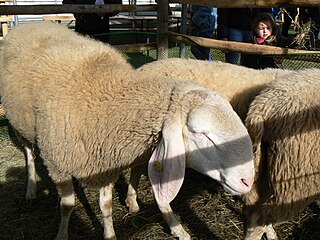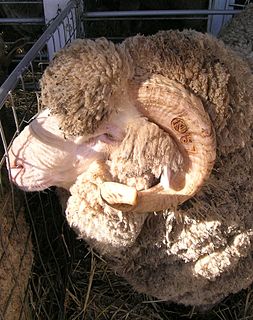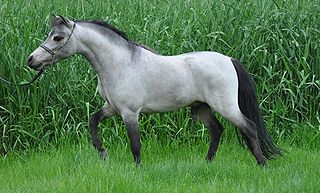Related Research Articles

The Charolais or Charolaise is a French breed of taurine beef cattle. It originates in, and is named for, the Charolais area surrounding Charolles, in the Saône-et-Loire department, in the Bourgogne-Franche-Comté region of eastern France. Charolais are raised for meat; they may be crossed with other breeds, including Angus and Hereford cattle.

The Pinzgauer is a breed of domestic cattle from the Pinzgau region of the federal state of Salzburg in Austria. It has distinctive colouring, with chestnut-brown sides and white back and underside. It was in the past a triple-purpose breed, raised for meat, milk and draught use. There is a naturally polled sub-type, the Jochberg Hummel. In 2007 the breed was not considered by the FAO to be at risk.

The Yonaguni or Yonaguni uma (与那国馬) is a critically-endangered Japanese breed of small horse. It is native to Yonaguni Island, in the Yaeyama Islands in south-western Japan, close to Taiwan. It is one of eight horse breeds native to Japan.

The Dosanko (道産子), also known as the Hokkaido Horse and Hokkaido Pony, is one of the eight extant indigenous horse breeds of Japan, and the only one of the eight not critically endangered. It originated on the island of Hokkaido, in the far north of the country, and is found particularly along the Pacific (eastern) coast of the island. The people of Hokkaido may be nicknamed "Dosanko" after the horses.

The Latvian Horse is a purpose-bred warmblood horse breed from Latvia. Breeding began in Latvia in the early twentieth century, and a herd book was established in 1927. The breed was officially recognised in 1952. There are two types, sometimes called the Latvian Harness Horse and the Latvian Riding Horse. The harness type was predominant until about 1960, when demand for sport horses increased and more of the saddle type were bred.

The Bosnian Mountain Horse is the only indigenous breed of domestic horse in Bosnia and Herzegovina, where it constitutes about 70% of the horse population. It is a small horse and is used both as a pack animal and for riding. Breed numbers were severely reduced during the Bosnian War of 1992–1995, and, unlike populations of other farm animals, continued to fall after the end of the war.

The Karabair is a long-established horse breed from Central Asia, and particularly from Uzbekistan and northern Tajikistan. It results from the cross-breeding of desert horses of Arabian or Turkmene type from the south with steppe horses from the north. It is a small, agile and versatile horse that can be used for riding or driving. It is well suited to local horse sports, and especially to the Uzbek national game, kokpar. It is also used for meat and milk production; the milk may be made into kumis.

The Valais Blackneck is a breed of domestic goat from the canton of Valais, in southern Switzerland, and neighbouring areas of northern Italy. The largest concentration is in the area of Visp (Viège). It is present in modest numbers in Austria and Germany. It is known by many names, including German: Walliser Schwarzhalsziege or Gletschergeiss; French: Col Noir du Valais, Chèvre des Glaciers or Race de Viège; and Italian: Vallesana or Vallese.
The Blazer is a modern American breed of riding horse, bred particularly for ranch work. It was developed by Neil Hinck of Star, Idaho, from a single foundation stallion named Little Blaze. He bred for intelligence, strength, gentleness, easy gaits and overall suitability for work on a ranch. A breed association, the American Blazer Horse Association, was established in 2006. The Blazer is not listed in the Global Databank for Animal Genetic Resources of the FAO, nor is it reported to DAD-IS.

The Bergamasca is a breed of domestic sheep from the mountainous part of the province of Bergamo, in Lombardy in northern Italy. It originates from the area of the Val Brembana and the Val Seriana valleys, and is particularly associated with the plateau of Clusone. By the beginning of the 20th century it had spread through much of Lombardy; it is now raised in most parts of mainland Italy, particularly the province of Teramo in Abruzzo, where more than 80% of the registered stock are kept. The Bergamasca is also present in Brazil, Serbia and Venezuela. It is raised principally for meat, and is often used for cross-breeding with other meat breeds to improve meat yield. In Lombardy, it is traditionally raised by transhumant management: the herds spend the summers on the alpine pasture, and over-winter in the Po valley.

The Balkan donkey or mountain donkey, Serbian: Domaći balkanski magarac, is a breed or group of breeds of domestic donkey originating in the Balkan region. It is reported from Serbia and Montenegro.
The Azerbaijan, is an Azerbaijani breed or group of breeds of riding horse of Oriental type. In 2007 it was listed by the FAO as endangered; in 2021 it was not among the horse breeds reported to DAD-IS.

The Boerperd is a modern breed of horse from South Africa. It is a re-creation of the traditional Cape Horse or old-type Boer Horse, which is now extinct.

The Kiso or Kiso Horse is one of the eight indigenous horse breeds of Japan. It is the only native horse breed from Honshu, the principal island of Japan. Like most other Japanese native breeds, it is critically endangered.

The Dongola or Dongolawi is an African breed of riding horse. It is predominantly of Barb type, though there may have been some Arab influence in the past. It originated in the Dongola province of Sudan, for which it is named. In eastern Africa it is distributed in the northern part of Sudan and in western Eritrea; it is also present in several West African countries including Cameroon, Chad and the Central African Republic. A number of local West African breeds or types derive from it; they may be regarded as sub-types, or may be reported as separate breeds.

The Swedish Red-and-White, Swedish: Svensk Röd och Vit Boskap, frequently abbreviated to SRB, is a Swedish breed of dairy cattle. It was created in the 1920s by crossing the Swedish Red Pied and Swedish Ayrshire breeds.
The Swedish Red Pied, Swedish: Rödbrokig Svensk Boskap, frequently abbreviated to RSB, was a Swedish breed of dairy cattle. It is now considered extinct. It was merged in the 1920s with the Swedish Ayrshire breed to create the Swedish Red-and-White, which is one of the principal dairy breeds of Sweden.

The Swedish Polled, Swedish: Svensk Kullig Boskap, often abbreviated to SKB, is a Swedish breed of domestic cattle. It was created in 1937 from two different Swedish cattle breeds, the Swedish Red Polled and the Fjäll. Breeders did not accept the new classification, and continued to maintain separate bloodlines as before. Of the two constituent breeds, the Swedish Red Polled received official recognition in 2004, while the Fjäll has divided into two sub-breeds, the Fjällnära Boskap and the Svensk Fjällras.

The Australian Merino is an Australian breed or group of breeds of sheep, forming a significant part of the Merino group of breeds. Its origins lie in Merino sheep imported to Australia from South Africa in about 1796. By about 1830 there were almost two million Merinos in the country.

The American Miniature Horse is an American breed of small or miniature horse. It has been selectively bred to display in miniature the physical characteristics of a full-sized horse, and usually stands no taller than about 38 in (97 cm). It frequently has the appearance of either a small Arab or a small draft horse; genetically it is no different to pony breeds such as the Shetland.
References
- 1 2 3 4 5 6 7 8 9 10 11 12 13 14 15 16 17 18 19 20 21 Sofjan Sudardjat (2007). National Report on Animal Genetic Resources Indonesia: A Strategic Policy Document; annex to: Barbara Rischkowsky, D. Pilling (eds.) (2007). The State of the World's Animal Genetic Resources for Food and Agriculture. Rome: Food and Agriculture Organization of the United Nations. ISBN 9789251057629. Accessed October 2014.
- ↑ Breeds reported by Indonesia: Horse. Domestic Animal Diversity Information System of the Food and Agriculture Organization of the United Nations. Accessed October 2014.
- ↑ Breed data sheet: Bali/Indonesia. Domestic Animal Diversity Information System of the Food and Agriculture Organization of the United Nations. Accessed October 2014.
- ↑ Breed data sheet: Batak/Indonesia. Domestic Animal Diversity Information System of the Food and Agriculture Organization of the United Nations. Accessed October 2014.
- ↑ Breed data sheet: Bima/Indonesia. Domestic Animal Diversity Information System of the Food and Agriculture Organization of the United Nations. Accessed October 2014.
- ↑ Breed data sheet: Flores/Indonesia. Domestic Animal Diversity Information System of the Food and Agriculture Organization of the United Nations. Accessed October 2014.
- ↑ Breed data sheet: Gayo/Indonesia. Domestic Animal Diversity Information System of the Food and Agriculture Organization of the United Nations. Accessed October 2014.
- ↑ Breed data sheet: Jawa/Indonesia. Domestic Animal Diversity Information System of the Food and Agriculture Organization of the United Nations. Accessed October 2014.
- ↑ Breed data sheet: kuda-Pacu Indonesia/Indonesia. Domestic Animal Diversity Information System of the Food and Agriculture Organization of the United Nations. Accessed October 2014.
- ↑ Breed data sheet: Kuningan/Indonesia. Domestic Animal Diversity Information System of the Food and Agriculture Organization of the United Nations. Accessed October 2014.
- ↑ Breed data sheet: Lombok/Indonesia. Domestic Animal Diversity Information System of the Food and Agriculture Organization of the United Nations. Accessed October 2014.
- ↑ Breed data sheet: Makasar/Indonesia. Domestic Animal Diversity Information System of the Food and Agriculture Organization of the United Nations. Accessed October 2014.
- ↑ Breed data sheet: Minahasa/Indonesia. Domestic Animal Diversity Information System of the Food and Agriculture Organization of the United Nations. Accessed October 2014.
- ↑ Breed data sheet: Sandel/Indonesia. Domestic Animal Diversity Information System of the Food and Agriculture Organization of the United Nations. Accessed October 2014.
- ↑ Breed data sheet: Sumbar-Sandel-Arab/Indonesia. Domestic Animal Diversity Information System of the Food and Agriculture Organization of the United Nations. Accessed October 2014.
- ↑ Breed data sheet: Sumbawa/Indonesia. Domestic Animal Diversity Information System of the Food and Agriculture Organization of the United Nations. Accessed October 2014.